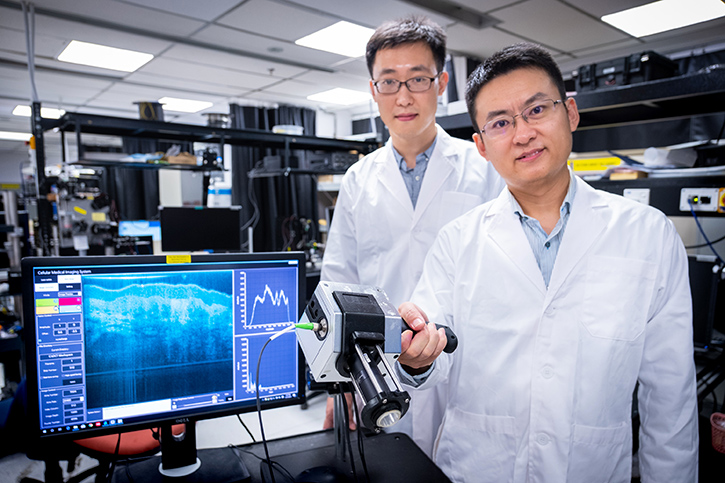Mar 26 2020
At Nanyang Technological University, Singapore (NTU Singapore), researchers have created a model of a portable medical imaging device that can generate images in the order of 1- to 2-µm resolution.
 (R-L) Assoc Prof Liu Linbo and one of his researchers Dr Xinyu Liu from NTU Singapore, have developed the prototype of a handheld medical imaging device, which produces images 100 times higher resolution than what X-Ray, computed tomography (CT) and Magnetic Resonance Imaging (MRI) machines can provide. Image Credit: Nanyang Technological University, Singapore.
(R-L) Assoc Prof Liu Linbo and one of his researchers Dr Xinyu Liu from NTU Singapore, have developed the prototype of a handheld medical imaging device, which produces images 100 times higher resolution than what X-Ray, computed tomography (CT) and Magnetic Resonance Imaging (MRI) machines can provide. Image Credit: Nanyang Technological University, Singapore.
This device is sufficiently comprehensive to detect the early signs of tumors that invade certain cells, and has a resolution that is approximately 100 times higher than that of the magnetic resonance imaging (MRI), computed tomography (CT), and X-ray machines.
The technology behind the novel device is the culmination of six years of optical imaging research, which was co-developed by the NTU team along with scientists at the University of Alabama, United States and the Harvard Medical School.
Depending on a novel imaging technology called micro “Optical Coherence Tomography” (OCT), the new device produces a spectrum of light that ranges between 700 to 950 nm, referred to as near-infrared light.
This light penetrates the human tissues and organs but does not cause any harm. Furthermore, the device subsequently quantifies the echo’s delay time from its light waves as they hit different tissue structures. This data will subsequently be used for constructing cross-section pictures of what is being scanned.
The achieved results are transferred in real-time to a computer system running the NTU-developed software. This software helps in the diagnosis by arranging the two-dimensional (2D) cross-section pictures into a three-dimensional (3D) image and rendering different parts in color.
According to the NTU team, the prototype device was mainly developed for use by medical professionals who are not experts in pathology or imaging. This enables them to scan patients using the novel device at the bedside or in clinics. This means, patients would not face the problem of waiting for the availability of CT or MRI scanner and needing attendance at a specialized center.
Our device is a fraction of the size of existing machines and produces clear, high-resolution images in real-time. It uses light to harmlessly penetrate the skin, and it does not involve specialised lead-shielded X-ray equipment or MRI scanners. It is small enough to be handheld, so images could be captured by the bedside.
Liu Linbo, Study Lead and Associate Professor, Nanyang Technological University, Singapore
At Wuhan University’s Endoscopic Centre, the prototype imaging device has been subjected to clinical trials and has demonstrated the potential in identifying atypical colon polyps to the same precision level as expert pathologists.
The initial trial was conducted at Wuhan University’s Renmin Hospital, where endoscopists utilized the device on 58 tissue samples collected from patients having colon polyps—that is, abnormal growths that occur in the rectum or colon.
Using the device, the samples were subsequently imaged in real-time. The device’s assessment of whether the samples were benign or malignant was found to be 95% precise after a comparison with the assessment made by senior pathologists on the same samples. These results were reported in the Clinical and Translational Gastroenterology journal, in June 2019.
Suzhou Sai Luo Er Medical Imaging Technology Co. Ltd, a Chinese medical technology firm, is now commercializing the new device.
One major promise of the new micro-OCT device is its potential capacity to detect the early signs of cancers of the skin, stomach, and colon, which start in the nuclei of epithelial cells and measure roughly 1 to 2 µm in size.
Epithelial cells are part of the obstacle between the outside and inside of the body (that is, lining within the organs, blood vessels, intestines, and throat), and they are virtually impossible to image using modern-day machines that cannot enter beyond 0.5 mm.
It is our hope that in future, doctors might be able to use a device like ours to precisely identify diseases as they develop at the cellular level, in real-time, and in high resolution. Through earlier detection, we believe that patients will receive an earlier diagnosis and if necessary, get treatment faster.
Liu Linbo, Study Lead and Associate Professor, Nanyang Technological University, Singapore
According to Dr Eng Soo Yap, a Consultant Haematologist at the National University Hospital in Singapore and who was not part of the research, “This is a ground-breaking technology that could have widespread clinical applications. These range from real-time imaging of tissues at a microscopic level to even detecting circulating cancer cells in the blood. All this could lead to early and more accurate detection of cancer.”
An additional advantage is that being a portable device, it could be used at the bedside, clinics and even in patient’s homes which would extend the accessibility of this technology and cut down on waiting time.
Dr Eng Soo Yap, Consultant Haematologist, National University Hospital
Along with his research team, Professor Liu is performing a more detailed analysis of OCT technologies, to additionally enhance the device and forge industry association with other healthcare firms.